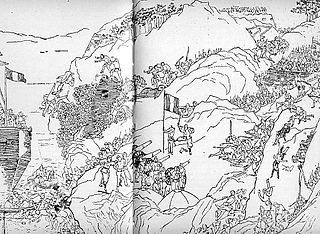 W
WThe Battle of Baguashan, the largest battle ever fought on Taiwanese soil, was the pivotal battle of the Japanese invasion of Taiwan. The battle, fought on 27 August 1895 near the city of Changhua in central Taiwan between the invading Japanese army and the forces of the short-lived Republic of Formosa, was a decisive Japanese victory, and doomed the Republic of Formosa to early extinction. The battle was one of the few occasions on which the Formosans were able to deploy artillery against the Japanese.
 W
WThe Battle of Changhsing, popularly known in Taiwan as the Battle of the Burning Village was the last set-piece battle during the Japanese invasion of Taiwan. It was fought by Hakka militia and armed civilians against the invading Imperial Japanese Army in Changhsing village (長興村). The battle earned its name from the fact that the entire village was burnt to the ground by the Japanese during their attempts to capture it from the Formosans.
 W
WThe Siege of Fort Zeelandia of 1661–1662 ended the Dutch East India Company's rule over Taiwan and began the Kingdom of Tungning's rule over the island. Taiwanese scholar Lu Chien-jung described this event as "a war that determined the fate of Taiwan in the four hundred years that followed".
 W
WThe Keelung campaign was a controversial military campaign undertaken by the French in northern Formosa (Taiwan) during the Sino-French War. After making a botched attack on Keelung in August 1884, the French landed an expeditionary corps of 2,000 men and captured the port in October 1884. Unable to advance beyond their bridgehead, they were invested inside Keelung by superior Chinese forces under the command of the imperial commissioner Liu Mingchuan. In November and December 1884 cholera and typhoid drained the strength of the French expeditionary corps, while reinforcements for the Chinese army flowed into Formosa via the Pescadores Islands, raising its strength to 35,000 men by the end of the war. Reinforced in January 1885 to a strength of 4,500 men, the French won two impressive tactical victories against the besieging Chinese in late January and early March 1885, but were not strong enough to exploit these victories. The Keelung campaign ended in April 1885 in a strategic and tactical stalemate. The campaign was criticised at the time by Admiral Amédée Courbet, the commander of the French Far East Squadron, as strategically irrelevant and a wasteful diversion of the French navy.
 W
WThe Pescadores campaign which took place in late March, 1885, was one of the last campaigns of the Sino-French War. It was fought to capture a strategically important island group off the western coast of Formosa (Taiwan). Admiral Amédée Courbet, with part of the French Far East Squadron, bombarded the Chinese coastal defences around the principal town of Makung (馬公) on Penghu Island (澎湖島) and landed a battalion of marine infantry which routed the Chinese defenders and occupied Makung.
 W
WThe Pescadores campaign was the last military operation of the First Sino-Japanese War and an essential preliminary to the Japanese conquest of Taiwan.
 W
WThe Taiwanese Resistance to the Japanese Invasion of 1895 was a conflict between the short-lived Republic of Formosa (Taiwan) and the Empire of Japan. The invasion came shortly after the Qing dynasty's cession of Taiwan to Japan in April 1895 at the end of the First Sino-Japanese War.
 W
WThe Battle of Tamsui, Danshui, or Hobe was a significant French defeat by the Qing dynasty at Tamsui on Taiwan during the Keelung Campaign of the Sino-French War.